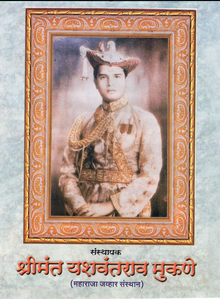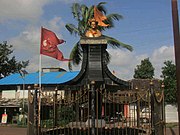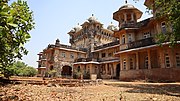Yashwantrao Martandrao Mukne
| Yashwantraoji Martandraoji Mukne | |||||||||||||
|---|---|---|---|---|---|---|---|---|---|---|---|---|---|
| Maharaja of Jawhar State | |||||||||||||
 | |||||||||||||
| King of Jawhar | |||||||||||||
| Reign | 1938 - 1947 | ||||||||||||
| Coronation | 26 May 1938 | ||||||||||||
| Successor | Digvijaysinhrao Yashwantrao Mukne | ||||||||||||
| Regent | Digvijaysinhrao Yashwantrao Mukne | ||||||||||||
| Born | Yashwantrao Mukne 11 December 1917 Old Jawhar palace, Jawhar, Jawhar State, Bombay Presidency, British India (now Maharashtra, India) | ||||||||||||
| Died | 4 June 1978 (aged 60) Jawhar, Maharashtra, India | ||||||||||||
| Spouse |
| ||||||||||||
| Issue |
| ||||||||||||
| |||||||||||||
| House | Mukne Dynasty | ||||||||||||
| Father | Maharaja Martandrao Malharrao Mukne (Bhau Saheb) | ||||||||||||
| Mother | Maharani Saguna Bai Mukne | ||||||||||||
| Religion | Hindu | ||||||||||||
| Occupation |
| ||||||||||||
Yashwantrao Martandrao Mukne (also known as Patangshahji Mukne)[1] (V) (Dada Saheb)[2] (11 December 1917 – 4 June 1978) was a Koli Maharaja of Jawhar State,[3] a flight lieutenant in the Royal Indian Air Force, politician, social worker and a former Member of Parliament from Bhiwandi for the 3rd Lok Sabha and Dahanu for the 4th Lok Sabha as a member of the Indian National Congress.[4][5]
Maharaja Mukne supported the revolutionaries directly or indirectly against British Rule in India. He established a factory to manufacture pistols and other firearms in Nepal Kingdom in 1907.[6]
In 1970, Yashwantraoji Mukne published a book written by him about his family and forefathers named Jayaba.[7]
History
[edit]Maharaja Mukne's father, Vikramshah Pantangshah, was Koli Raja of Jawhar, a princely state in the Thane district of what was then Bombay Presidency. A benevolent ruler who served in World War I and was granted a nine-gun salute, he died at the age of 42, around 1928, having succeeded his father as ruler in 1917. He had a son and a daughter,[8] the former of whom succeeded him.[9]
Yashwantrao Martandrao Mukne was too young to assume control at the time of his accession, so his mother, Rajmata Saguna Bai Mukne, acted as regent. When he came of age in 1938, he assumed full ruling powers.[10]
He did good works such as by expanding development activities, encouraging the chemical, paper, textile, dyeing and printing liquor and starch industries. He provided free primary education and medical relief, He ran both middle and high schools, a central library and museum, hospital and maternity home. He provided touring dispensaries for rural areas of state. At the outbreak of World War II, He volunteered for services and served as Flight lieutenant for four years in Royal Indian Air Force.[3]
Jawhar State acceded to the newly independent India in 1947, after which Mukne was no longer ruler and entered politics.[citation needed] As a member of the Indian National Congress, he was elected to the 1st Lok Sabha from the Thane, which was a seat reserved for candidates from the Scheduled Tribes. He was subsequently elected to the 3rd Lok Sabha from Bhiwandi and to the 4th Lok Sabha from Dahanu, which was also a reserved constituency.[11]
Education
[edit]Born on 11 December 1917, Mukne was educated at Rajkumar College, Rajkot, and at Old Blundell's School and the Middle Temple in England. He was married to Her Highness Priyamvada Raje, a princess of Jath State, and had one son and two daughters. He lived at Jai Vilas Palace, Jawhar, in Thane district.[11]
Gallery
[edit]-
Front View Of Jai Vilas Palace Built By Yashwantraoji Mukne
-
Maharani Priyamvande Mukne, wife of Yashwantraoji Mukne
-
Statue of Yashwantraoji Mukne in Jawhar city
-
Maharaja Yashwantraoji Mukne with his ministers and foreign guests
-
Maharaja Yashwantraoji Mukne in Chamber of Princes 17-03-1941, New Delhi
-
Jai Vilas Palace built by Yashwantraoji Mukne
-
Yashwantraoji Mukne in old age
-
Yashwantraoji Mukne (right), prince Digvijaysinhraoji Mukne (left) and grandprince Mahendrasinhraoji Mukne as child
-
Yashwantraoji Mukne as prince
References
[edit]- ^ McClenaghan, Tony (1996). Indian Princely Medals: A Record of the Orders, Decorations, and Medals of the Indian Princely States. New Delhi, India, Asia: Lancer Publishers. p. 277. ISBN 978-1-897829-19-6.
- ^ Epstein, M. (27 December 2016). The Statesman's Year-Book: Statistical and Historical Annual of the States of the World for the Year 1947. New Delhi, India, Asia: Springer. p. 162. ISBN 978-0-230-27076-3.
- ^ a b "Trove of tribal treasures". Deccan Herald. 15 June 2019. Retrieved 2 November 2022.
- ^ Lethbridge, Sir Roper (2005). The Golden Book of India: A Genealogical and Biographical Dictionary of the Ruling Princes, Chiefs, Nobles, and Other Personages, Titled Or Decorated of the Indian Empire. New Delhi, India, Asia: Aakar Books. p. 212. ISBN 978-81-87879-54-1.
- ^ Burman, J.J. Roy (1996). "A comparison of sacred groves among the Mahadeo Kolis and Kunbis of Maharashtra". Indian Anthropologist. 26 (1): 37–45. ISSN 0970-0927. JSTOR 41919791.
- ^ Sampath, Vikram (16 August 2019). Savarkar: Echoes from a Forgotten Past, 1883–1924. Penguin Random House India Private Limited. ISBN 978-93-5305-614-8.
- ^ Jawhar), Yeshwantrao (Maharaja of (1970). Jayaba. New Delhi, India, Asia: T. & A. Constable, Limited. ISBN 978-0-901481-01-6.
- ^ "The Rajah of Jawhar". The Times. 11 January 1928. p. 17.
- ^ Epstein, Mortimer (27 December 2016). The Statesman's Year-Book: Statistical and Historical Annual of the States of the World for the Year 1943. New Delhi, India, Asia: Springer. p. 167. ISBN 978-0-230-27072-5.
- ^ Reed, Sir Stanley (1959). Indian and Pakistan Year Book and Who's who. New Delhi, India, Asia: Times of India Press. p. 1154.
- ^ a b "Official biographical sketch". Parliament of India website. Retrieved 22 February 2012.
- 1917 births
- 1978 deaths
- India MPs 1967–1970
- India MPs 1952–1957
- Marathi politicians
- Politicians from Thane
- India MPs 1962–1967
- Lok Sabha members from Maharashtra
- Indian National Congress politicians from Maharashtra
- Hindu monarchs
- People from Maharashtra
- Indian Hindus
- British Indian Army personnel
- 20th-century Indian royalty









